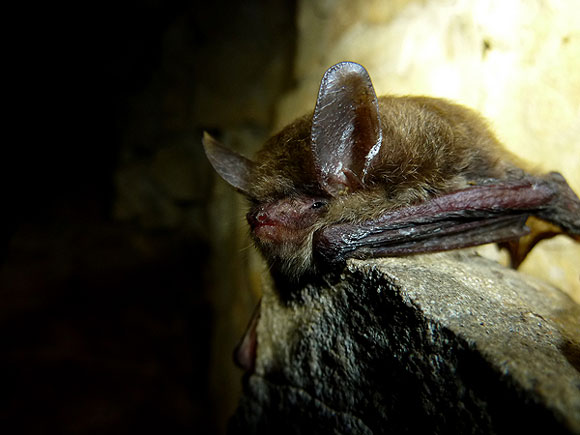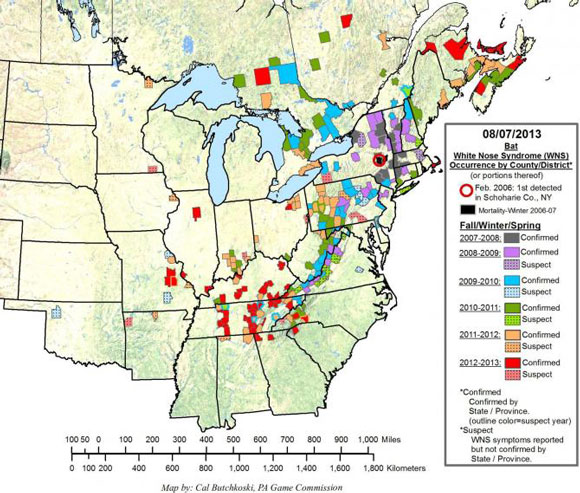The deadly fungus that causes white-nose syndrome in bats is continuing to spread west across North America. Wildlife officials confirmed on July 29, 2013 that the invasive fungus has spread to at least two caves in Arkansas. The fungus is also suspected to be present in a cave in western Oklahoma. These locations are the farthest west that scientists have detected the fungus since it was first discovered in New York in 2006. Scientists are predicting that the fungus could reach the Rocky Mountains as early as 2015 and the west coast by the mid 2030s.
The fungus that causes white-nose syndrome in bats is believed to have hitchhiked from Europe to North America on the shoes or clothing of someone who then went caving. The fungus was first detected in New York in 2006. Since its introduction to North America, the fungus has killed an estimated 5.7 to 6.7 million bats. The fungus kills bats by disrupting their ability to hibernate in the winter. The disease was named white-nose syndrome because bats infected with the fungus often have white, fuzzy growths on their nose and ears. Bats in North America are likely susceptible to the fungus because they have not yet had time to develop resistance to the disease.

White-nose syndrome poses a threat to several endangered North American bat species including gray bats and Indiana bats. Wildlife officials are also concerned that the disease could curtail the ability of bats to control insect pests, which is important to the production of agricultural crops. The fungus is not known to pose a direct threat to humans, pets, or livestock.
The fungus appears to be spreading across North America primarily through bat-to-bat contact, but humans are thought to be capable of inadvertently spreading the fungus through contaminated clothing and caving equipment.
Swab samples taken from hibernating bats in Arkansas during February 2012 and January 2013 have tested positive for the fungus, wildlife officials announced on July 29, 2013. The samples were analyzed with a new sensitive DNA test that can identify the fungus. The study, funded by the National Science Foundation, was part of a national effort led by scientists at the University of California Santa Cruz and Northern Arizona University to track the disease. Although the fungus was detected in Arkansas, the bats there are not yet showing visible signs of white-nose syndrome.
Ann Froschauer, a spokeswoman for the US Fish and Wildlife Service, told the BBC news that:
As we have got better at the science side of things, we have been able to develop more sensitive [tests] that can detect the fungus in the environment in the absence of sick bats. We have seen that there seems to be some sort of timeline from when the fungus arrives in an area and when we start seeing the disease start manifesting itself in the bat population.
Wildlife officials are also keeping a close watch on a potentially contaminated site further west in Oklahoma, but the results there have not yet confirmed the presence of the fungus in bats.
So far, white-nose syndrome has been confirmed in 22 states across the US and five Canadian provinces. The fungus is suspected to present in at least 4 other states in the US.

A study published in Nature Communications on December 18, 2012, predicts that white-nose syndrome could reach the Rocky Mountains as early as 2015. Then, the fungus is expected to continue to its spread west. Results from simulation models suggest that the fungus may reach the west coast by the mid 2030s.
To help prevent the spread of white-nose syndrome, wildlife officials are asking people to report any sightings of sick bats to your state wildlife agency. Also, please respect cave closures and follow decontamination procedures when visiting caves that are open.
Bottom line: Wildlife officials confirmed on July 29, 2013 that the invasive fungus that causes white-nose syndrome in bats has spread to at least two caves in Arkansas. The fungus is also suspected to be present in a cave in western Oklahoma. These locations are the farthest west that scientists have detected the fungus since it was first discovered in New York in 2006. Scientists are predicting that the fungus could reach the Rocky Mountains as early as 2015 and the west coast by the mid 2030s.
World’s largest urban bat colony











